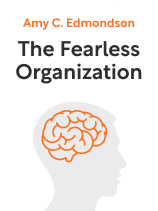

This article is an excerpt from the Shortform book guide to "The Fearless Organization" by Amy C. Edmondson. Shortform has the world's best summaries and analyses of books you should be reading.
Like this article? Sign up for a free trial here.
Do your employees just nod and listen? How can you get employees to speak up?
The Fearless Organization by Amy C. Edmondson says that leaders must create a safe space for employees to ask questions, engage in debate, and learn from one another. Building psychologically safe work cultures enables workers to tap into their creativity and innovate, which in turn improves their engagement and performance.
Find out how to encourage employees to speak up below.
Encourage Employees to Speak Up
As a leader, you can learn how to encourage employees to speak up by modeling curiosity and humility, asking thoughtful questions, and putting structures in place that support your efforts to engage employees. This will bring workers into the fold, inspire them to replicate behavior you want to embed in your organizational culture, and foster employees’ belief that what they have to say is important.
(Shortform note: Experts say that creating a safe space isn’t the only thing you have to do to foster creativity and innovation. You must also provide basic support, direction, and parameters to keep employees from going off the rails; avoid micromanaging so you don’t stifle ideas; and level the idea-generation playing field for introverts and extroverts by encouraging workers to take time to themselves to identify new ideas.)
Model Curiosity and Humility
According to Edmondson, acknowledging that you don’t know the answer to everything, admitting your failures and when you’re wrong, and asking for help shows others that you have the confidence and strength to be vulnerable. By demonstrating that nobody is all-knowing or perfect, you create a safe space for others to be vulnerable, take risks, speak up, share their knowledge, and make mistakes—which supports workers’ ability to realize their fullest potential and realize company goals.
(Shortform note: In Dare to Lead, Brené Brown argues that facing your flaws and failures openly is at the core of brave leadership. Contrary to what some believe, practicing vulnerability doesn’t mean you have to spill the beans on every challenge you’ve ever faced. It simply means talking candidly about uncertainty or risk, discussing your feelings about those things, and encouraging employees to discuss those things if they want to. She cautions leaders against faking vulnerability or manipulatively oversharing vulnerable information to garner sympathy for selfish purposes, which doesn’t advance the cause of helping workers realize their fullest potential and company goals.)
Employ a Thoughtful Inquiry Process
Asking employees questions can help you learn more about situations and challenges you need to understand to run your organization effectively. To ask thoughtful questions:
1) Ask open-ended questions that provoke deeper thought and further discussion (as opposed to yes/no questions, which tend to shut conversations down).
2) Phrase questions in a way that encourages respondents to give specific answers. For example, if you want a broader understanding of a situation, you might ask: “What aren’t we seeing in this situation?” or “Who has another way of thinking about this?” Or if you want to understand a situation more deeply, you might ask, “Why do you think that?” or “What are some examples of what you’re saying?”
(Shortform note: Experts say that employee-centered management strategies, like asking workers for ideas and feedback, are more important now than ever. In a world of work defined by quick and disruptive change, 21st-century managers must operate as coaches who provide support and solicit information from workers to channel their energy and creativity, not command-and-control bosses who dole out instructions and answers. In this coaching role, they should embrace “situational coaching,” which balances drawing on workers’ insights and providing direction to help them resolve challenges they face.)
Edmondson says you can also elicit information from employees by creating structures designed to get them to speak up rather than stay silent. For example, schedule regular focus groups to solicit employee input. Alternatively, establish peer-to-peer, inter-team teaching and learning groups to foster inquiry and build knowledge—a structure that comes with the added benefit of increasing trust and decreasing employees’ fear of judgment from members of teams they don’t know.
(Shortform note: Other structures you can create to solicit employee feedback include formal channels that protect and promote workers’ voices, like an ombuds office, where employees can bring forward concerns and file formal reports about issues they’re worried about, such as bullying or mismanagement. Companies can also create anonymous reporting channels for workers, such as hotlines, web bots, and phone apps that enable employees to share information without fear of retaliation.)
Respond Thoughtfully When Employees Engage
Edmondson claims that positively reinforcing employees when they engage and speak up encourages them to continue speaking up. This is particularly important in workplaces defined by uncertainty, where workers may encounter negative outcomes even when they do everything right. For example, school teachers may use identical methods to teach two students in the same class, but they may have mixed results due to factors beyond their control, such as the students being in different places developmentally.
(Shorform note: Experts say that if you want to encourage employees to continue speaking up, you should positively frame your messaging around the practice. For example, to encourage the general practice of speaking up, frame silence as “everyone’s problem,” which communicates that speaking up is a common goal and that everyone is “in it together.” Or, to encourage people to report bullying, harassment or discrimination, frame reporting these issues as “showing compassion” or “supporting others” to convey that those who report will be treated with empathy.)
To positively reinforce employees for speaking up, listen carefully when they ask questions and share concerns, thank them for their contributions, offer ongoing support, and normalize failure to reduce fears around making and discussing mistakes. Edmondson says that even if you don’t like or agree with workers’ feedback, you should continue to encourage them to speak up, which you can do by saying: “I appreciate you bringing this to my attention.” Your goal is not to love everything they share with you, but to consistently communicate that a) you welcome their voices and b) learning is an ongoing process that’s vital to their and the company’s success.
(Shortform note: In Radical Candor, Kim Scott argues that leaders should employ two types of listening skills: quiet and loud. In quiet listening, you insert silence in conversations so the person you’re speaking to can elaborate on what they’re thinking. Because silence can make people uncomfortable, balance it with asking questions to help the other person open up. Loud listening centers on directly stating your thoughts about a situation to compel the person you’re talking with to react. This is a good way to quickly communicate where you stand on an issue, but it can intimidate people. So, to keep the discussion flowing, upon making your statement, ask the other person what they think and if there are any flaws in your logic.)
Example: Pixar Fosters Trust and Openness to Yield Strong Results
Pixar co-founder Ed Catmull says the company has been successful because it has created a high level of openness to dissenting opinions at all organizational levels—key features of psychological safety. Pixar formed a “braintrust” group that meets regularly to provide feedback about the company’s films. Rules for giving feedback include that you have to a) be honest, constructive, and target the product, not the person who created it; b) offer suggestions, not mandates; and c) come from a place of genuine empathy, not snarkiness or hostility. The rules for receiving feedback are that you can’t dismiss it, get defensive, or take it personally.
(Shortform note: Though many tout the positive results of the Pixar braintrust’s psychologically safe culture and feedback process, the process doesn’t translate for everyone who tries it: Game company King tried and failed to implement its own braintrust. King’s meetings with executives, studio heads, and game directors turned into “dog and pony” shows where a) presenters pitched project ideas not to get feedback, but to acquire resources, and b) braintrust members were incentivized to see presenters’ projects fail so they could snatch up those resources. King’s failure appears to stem from multiple factors, including that they lacked the level of trust, respect, and expertise that Pixar has.)

———End of Preview———
Like what you just read? Read the rest of the world's best book summary and analysis of Amy C. Edmondson's "The Fearless Organization" at Shortform.
Here's what you'll find in our full The Fearless Organization summary:
- The importance of psychological safety in the workplace
- How leaders and non-leaders can foster psychologically safe environments
- Why workers should be able to make mistakes without fear of reprisal






